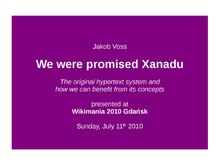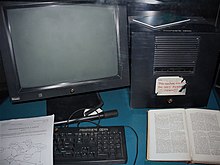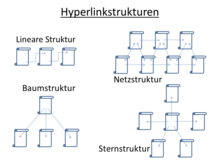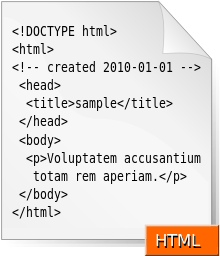Hypertext
A hypertext ( English pronunciation [ ˈhaɪ̯pɐˌtɛkst ], word formation from ancient Greek ὑπέρ hyper- , German 'over, above, beyond… beyond' and Latin texere 'weave, braid' ) is a text with a net-like , dynamic structure in which the usual order (linear sequentiality) of static printed publications is technically broken up.
It differs from the typical book in that it is not written to be read from start to finish in the order in which it is published. It is written in markup languages which, in addition to design instructions that are not visible to the reader, also contain hyperlinks , i.e. cross-references to distant text passages or other documents in the network . The most common markup language for Internet documents is Hypertext Markup Language (HTML), which is ubiquitous today. A hypertext can be described informatically as a network of hypertext nodes that are connected by hyperlink edges .
The concept goes back to Vannevar Bush's MEMEX from 1945. The term was coined by Ted Nelson in 1965 . In terms of cultural history, the invention of the hypertext is closely linked to the encyclopedic idea and the idea of the universal library and should contribute in practice to the findability of published research results and the development of better typewriters . The World Wide Web Consortium (W3C) provides the relevant definition .
definition
The definition attempt by the World Wide Web Consortium (W3C) can be assumed to be decisive:
- Hypertext is a text that does not have to be linear (not constrained to be linear) .
- Hypertext is text that contains links to other texts.
- HyperMedia is a hypertext that can also contain graphics, videos or sounds (not constrained to be text) .
- Hypertext and HyperMedia are concepts, not products.
Types of hypertext systems
In 1987 Jeffrey Conklin systematically investigated the properties of 18 hypertext systems and created four system classes based on typical use cases:
- Macro-literary systems which , with the aid of machines, facilitate the handling of large online libraries and are intended to serve as a platform for all relevant work steps such as publishing, reading, collaborating and criticizing.
- Heuristic tools (problem exploration) , with the help of which the first unstructured idea generation phase of a work process can be transferred to drafting, problem solving, programming or design.
- Reading systems (browsing systems) , which should above all be low-threshold, to be used in teaching, for looking up or in public places.
- General hypertext technology , which is primarily intended to serve experimental purposes.
History and Development
Precursors and historical concepts
Not every property of hypertext is a 20th century innovation. Some of the indexing aids for traditional linear texts, such as tables of contents , indices , cross-references and footnotes and other reference systems , which have already been introduced and used in the modern writing system, can be assigned to functionally specific writing and editing techniques of hypertext. In contrast to digital hypertext systems, however, the reference targets must be present on site in the case of material texts so that the reader can follow the reference, and the tracking of the references cannot be done mechanically.
As mechanical precursor digital hypertext systems are Agostino Ramelli Bücherrad from the 16th century and Roussel reading machine , a kind of minute wheel for note list .
Paul Otlet , co-founder of the Office International de Bibliographie in Brussels in 1895 , editor of the universal classification and a pioneer of the League of Nations , is considered an early pioneer of hypertext due to his systematic efforts to create a universal library with a universal bibliography (the mundaneum ).
As We May Think (1945)
The modern hypertext concept was introduced in 1945 by US science organizer and policy advisor Vannevar Bush in the essay As We May Think , which appeared in The Atlantic Monthly . Based on the research policy demand to improve scientific cooperation in the service of the global and peaceful improvement of the living conditions of mankind and to coordinate it more skilfully, Bush presents the concept for the MEMEX ( Memory Extender ), a networked writing / reading machine that never actually works was constructed. In MEMEX , the collected literature of a certain area can be presented, cited and annotated electronically and easily accessible. Citations and annotations can be exchanged between individual devices and users. A central function is to switch between texts, for example to follow footnotes and references , whereby the MEMEX user's "reading trace" can be electronically recorded and tracked at any time. One of Bush's prognoses is that “encyclopedias of a completely new type” would also emerge in this way.
A File Structure for the Complex, the Changing and the Indeterminate (1965)
The philosopher and computer scientist Ted Nelson ( Project Xanadu ) coined the term hypertext in 1965 in a published lecture to the American Association for Computing Machinery (ACM) entitled A File Structure for the Complex, the Changing and the Indeterminate . Based on the activities, processes and tools that are used in the well-known analog text production, he describes a computer-based typewriter that combines and expands all previously known and used techniques as a universal tool. As extensions, he suggests a versioning system, technical support for collaborative text production, citation objects and a system of needs-based text assembly. His technological proposals are based on the philosophical conviction that even cognitive categories change dynamically, and therefore a writing system should be able to be dynamically adapted. One can rightly compare Nelson's draft with the realized Wikipedia (or the MediaWiki software). Nelson himself calls his ideal collaborative dynamic system the Dream File , the technical side of which is an Evolutionary List File (ELF) based on very simply structured "zipped" lists.
Information Management: a Proposal (1989)
The first hypertext system that was manageable due to its practicality was developed in 1989 by the British physicist and computer scientist Sir Tim Berners-Lee at the European Organization for Nuclear Research (CERN) in Geneva. Berners-Lee successfully proposed to the management of CERN to reduce data loss and multiple work through improved information management around the experiments carried out. Technically, this new information management should be implemented with the help of a network-like data structure with a client-server model , the language of which should be hypertext. Berners-Lee hoped in this way the limitations and problems of hierarchical "tree systems" and "keyword catalogs" ( keywords to bypass). From this historical proposal, the World Wide Web (WWW) developed, the structure and description of which is still maintained and developed by the World Wide Web Consortium under the direction of Berners-Lee.
properties
Compared to linear information representations, hypertext codes complex information with comparatively little redundancy . Freedom from redundancy saves memory and transmission bandwidth and simplifies the maintenance and updating of content, because a centrally stored value only needs to be changed once in order to be displayed in all places that are linked to the value.
The associative structure of a hypertext seems to be more like the way human thought works than purely linear texts . In this context, the educator Rolf Schulmeister refers to the “cognitive plausibility hypothesis”.
Concrete hypertext systems and technical precursors
The widespread presence in the most hypertext system is the Internet service World Wide Web (WWW), which in 1989 by Sir Tim Berners-Lee was proposed at CERN. The markup language that is used in a standardized way is Hypertext Markup Language (HTML). The technical specifications and versioned further developments are proposed by the internationally recognized World Wide Web Consortium (W3C, chaired by Sir Tim Berners-Lee) and typically adopted in international and national standardization procedures. The WWW also allows non-linguistic data types such as images to be incorporated, so it is strictly speaking a hypermedia system.
Emanuel Goldberg patented the “ statistical machine ” in the USA in 1931 , which was supposed to add, sort and perform other “statistical operations” with the help of light beams and photoelectric tubes. This invention can be linked to the development of the MEMEX.
Roberto Busa is considered to be one of the pioneers of the scientific application of EDP in the humanities ( Digital Humanities ) and from 1946 was the editor of the Index Thomisticus, a 56-volume cataloging aid for the works of Thomas Aquinas with 70,000 pages. By using IBM technology, Busa was able to reduce the duration of the edition from an estimated forty to seven years. His system can be described as hypertext-shaped.
HyperCard from Apple was conducted as part of the software features of the Macintosh shipped and was soon a larger group of users to access.
Hypertext and literature
The Austrian writer Andreas Okopenko is regarded as the literary pioneer of hypertext, who published the first literary hypertext in book form in 1970 with his lexicon novel . The lexicon novel was published in 1998 in collaboration between the author, the collective Libraries of the Mind and the composer Karlheinz Essl junior as ELEX - Electronic Lexicon-Roman on CD-ROM.
A fictional narrative that is written with and for the hypertext structure is called hyperfiction . Like Afternoon - A story (1987) by Michael Joyce, it can also be published in print as offline hyperfiction .
Complex classics of modern literature such as James Joyce 's Finnegans Wake (1939), which can be read as “network-like”, or Zettel's dream (1970) by Arno Schmidt can be seen as precursors of hyperfiction . An example of a hypertext-like poem is the Hundred Thousand Billion Poems by Raymond Queneau (1961).
Research questions
One problem with working with hypertext is finding information in a targeted manner . While literate people have been trained in the reception of linear texts for centuries , it was only with the increasing spread of the World Wide Web in the mid-1990s that people began to learn how to deal with complex hypertexts. Tools such as search engines and search functions on the websites support the user.
Technically, the WWW lacks important functions of earlier hypertext systems. For example, the problem of the so-called dead links in the WWW, which do not or no longer lead to the desired destination, is unsolved. The introduction of the Uniform Resource Identifiers (URIs) is only incompletely fulfilled via the URLs commonly used on the web .
Another problem is navigating in hypertexts, as a reading structure specified by the author (for example a guided tour ) was often missing , especially in the early years . Today, hypertexts usually have sophisticated navigation . An excess of cross-references can lead to so-called information overload , flooding with disordered information and disorientation in the widely branched network of texts (lost in hyperspace ). Reading habits play an important role here. This means that online-savvy users have less difficulty interrupting reading a text in order to follow a cross-reference. Problem-solving approaches offer virtual mind maps and web ontologies . The problem of the visualization of hypertexts, i.e. the graphically prepared representation of the typically network-shaped and therefore not hierarchically presentable structure of a hypertext (see also Hyperbolic Tree ), has only been partially solved .
In hypertext, the order in which word components ( lexia ) are presented is variable . Marie-Laure Ryan takes the view that the description of hypertext as non-linear is not entirely accurate, because what is selected in the reading process still maintains a linear order ( sequential order ). Instead, Ryan suggests the term multilinear for this peculiarity of hypertexts .
See also
literature
Primary texts
- Sir Tim Berners-Lee : Information Management: a Proposal. CERN 1989, ( w3.org ).
- Theodor Holm Nelson : Complex Information Processing: A File Structure for the Complex, the Changing and the Indeterminate . ACM, New York, NY 1965, pp. 84-100 , doi : 10.1145 / 800197.806036 .
- Vannevar Bush : As We May Think. Atlantic Monthly (176), pp. 101-108 ( theatlantic.com ).
- Paul Otlet : Traité de documentation , Brussels 1934. Reprint: Center de lecture publique de la Communauté française de Belgique 1989, ISBN 2-87130-015-1 ( archive.org ).
Text collections
- Karin Bruns, Ramón Reichert (Ed.): Reader New Media. Texts on digital culture and communication. (Cultural Studies 18), Bielefeld, transcript 2007, ISBN 978-3-89942-339-6 (collection of relevant basic texts in German translation).
- Noah Wardrip-Fruin, Nick Montfort (Eds.): The New Media Reader. MIT Press, Cambridge / Mass. 2003, ISBN 978-0-262-23227-2 (English, monoskop.org PDF, annotated collection of relevant basic texts ).
Research literature
- Christian Vater: Hypertext - Wikipedia and the software dispositive: a digital collaborative online encyclopedia for the "Turing galaxy" - and the history of hypertext. In: Eva Gredel, Laura Herzberg u. Angelika Storrer (Ed.): Linguistic Wikipedistik (= Discourses - digital, special issue 1), pp. 1–25, 2019, ISSN 2627-9304 . ( OpenAccess + PDF, CC BY NC 4.0 )
- Christian Vater: Hypertext - A typeface for networked, dynamic typewriters (1965). In: Michaela Böttner, Ludger Lieb , Christian Vater, Christian Witschel (Eds.): 5300 Jahre Schrift , Heidelberg, Wunderhorn 2017, ISBN 978-3-88423-565-2 ( OpenAccess + PDF ).
- Frank Hartmann : (Ed.): From book to database: Paul Otlet's utopia of knowledge visualization. Avinus, Berlin 2012, ISBN 978-3-86938-025-4 ( publisher information ).
- Jakob Krameritsch: History (s) in the network. Hypertext and its potential for the production, representation and reception of the historical narrative. (Media in Science. Vol. 43). Waxmann, Münster 2007, ISBN 978-3-8309-1835-6 .
- Angelika Storrer: Hypertext Linguistics . In: Nina Janich (Ed.): Text Linguistics. 15 introductions. Narr, Tübingen 2008/ 2 2019, ISBN 978-3-8233-6432-0 ( hytex.tu-dortmund.de preprint, PDF).
- George P. Landow: Hypertext 3.0. Critical Theory and New Media in an Era of Globalization. 3. Edition. Johns Hopkins Univ. Press, Baltimore Md 2005, ISBN 0-8018-8257-5 .
- Angelika Storrer: Text and Hypertext . In: Henning Lobin, Lothar Lemnitzer : Text technology. Perspectives and Applications. Stauffenburg, Tübingen 2004, ISBN 3-86057-287-3 .
- Christiane Heibach: Literature in Electronic Space , Suhrkamp, Frankfurt am Main 2003, ISBN 3-518-29205-6 (previously: Literature on the Internet: Theory and Practice of a Cooperative Aesthetic. ), University of Heidelberg, Dissertation, 2000.
- Stefan Iske: Networked knowledge. Hypertext Strategies on the Internet. Bertelsmann, Bielefeld 2002, ISBN 3-7639-0151-5 .
- Stephan Porombka: Hypertext. To criticize a digital myth. Fink, Munich 2001, ISBN 3-7705-3573-1 .
- Angelika Storrer , What is “hyper” about hypertext? In: Kallmeyer, Werner (ed.): Language and new media (1999 yearbook of the Institute for German Language). De Gruyter, Berlin a. a. 2000, ISBN 3-11-016861-8 ( ids-pub.bsz-bw.de ).
- Rainer Hammwöhner : Open hypertext systems. The Konstanz Hypertext System (KHS) in a scientific and technical context. Univ.-Verl. Konstanz, Konstanz 1997, ISBN 3-87940-608-1 .
- Peter Schnupp: Hypertext. Oldenbourg, Munich 1992, ISBN 3-486-21740-2 .
- Rainer Kuhlen : Hypertext. A non-linear medium between book and knowledge base. Springer, Berlin 1991, ISBN 3-87940-509-3 .
- Jay David Bolter : Writing Space: The Computer, Hypertext, and the History of Writing. Hillsdale, Lawrence Erlbaum 1990/ 2 2001, ISBN 0-8058-0427-7 .
- Jeffrey Conklin: Hypertext: An Introduction and Survey , Computer (20), pp. 17-41, September 1987, doi: 10.1109 / MC.1987.1663693 (PDF ics.uci.edu ).
Web links
- Definition of the W3C (authoritative and relevant)
- The history of knowledge processing as a timeline at Wolfram Alpha
- The Electronic Labyrinth (Formerly hypertext over hypertext, 1993-2001 Christopher Keep, Tim McLaughlin, Robin Parmar. Index and bibliography)
- Thomas Dreher (2011f.) In IASonline on the history of hypertext (with good illustrations and with a focus on hypertext literature )
- Bee-Hive the Hypertext / Hypermedia Literary Journal
- Cyberfiction - Swiss magazine that deals with hypertext / -fictions
- Hypertext and Linguistics - Dissertation by Oliver Huber
- 'Der Looppool' - A hypertext example for listening, reading and controlling yourself, Bas Böttcher
- The SelfHTML - Wiki (good introduction to learning the most common description language HTML)
Individual evidence
- ↑ a b Relevant definition of the W3C (accessed on September 13, 2017)
- ↑ Jeffrey Conklin: Hypertext: An Introduction and Survey , Computer (20), pp. 17–41, September 1987, doi: 10.1109 / MC.1987.1663693 ( ics.uci.edu PDF)
- ^ Frank Hartmann : From index cards to the networked hypertext system. Paul Otlet, Architect of World Knowledge. From the Early History of the Information Society. In: Telepolis . 10/2006 ( heise.de ).
- ↑ Vannevar Bush : As We May Think. In: Atlantic Monthly. 176, pp. 101-108. ( theatlantic.com ).
- ^ Theodor Holm Nelson: Complex Information Processing: A File Structure for the Complex, the Changing and the Indeterminate . ACM, New York, NY 1965, pp. 84-100 , doi : 10.1145 / 800197.806036 .
- ↑ Christian Vater: Hypertext - A font for networked, dynamic typewriters (1965) . In: Michaela Böttner, Ludger Lieb , Christian Vater, Christian Witschel (eds.): 5300 years of writing. Wunderhorn, Heidelberg 2017, ISBN 978-3-88423-565-2 . ( OpenAccess + PDF )
- ^ Tim Berners-Lee : Information Management: a Proposal , CERN 1989, ( online via w3.org , accessed September 12, 2017).
- ^ Rolf Schulmeister : Basics of hypermedia learning systems. Wessley, Bonn 1996, ISBN 3-89319-923-3 , p. 257.
- ↑ Michael Buckland: Emanuel Goldberg, Electronic Document Retrieval, And Vannevar Bush's Memex. In: Journal of the American Society for Information Science. New York 43.1992, 4 (May), ISSN 0002-8231 , pp. 284-294.
- ↑ "Religion: Sacred Electronics" , Time , December 31, 1956 accessed on 15 August 2011th
- ^ "Morto padre Busa, è stato il pioniere" , Corriere del Veneto , accessed on August 15, 2011
- ^ Christian Zolles: Hypertext pioneer now in hypertext. In: ORF Science. December 17, 2018, accessed March 2, 2019 .
- ↑ essl.at
- ^ Marie-Laure Ryan: Narrative and Digitality: Learning to Think With the Medium. In: James Phelan , Peter J. Rabinowitz (Eds.): A Companion to Narrative Theory. Blackwell Publishing, Malden / Massachusetts / Oxford 2005, paperback edition 2008, ISBN 978-1-4051-1476-9 (PDF table of contents ), pp. 515-528.





